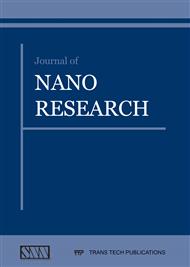[1]
X. Fan1, W. Zheng, D. Singh, Light scattering and surface plasmons on small spherical Particles, Light: Science & Applications 3(2014) e179.
DOI: 10.1038/lsa.2014.60
Google Scholar
[2]
M. V. Rybin etal., Fano resonances in antennas: General control over radiation patterns, Phys. Rev. B 88(2013) 205106.
Google Scholar
[3]
P.K. Jain, X. Huang, I.H. El-Sayed, M.A. El-Sayed, Noble metals on the nanoscale: optical and photothermal properties and some applications in imaging, sensing, biology, and medicine, Acc. Chem. Res. 41 (2008) 1578–1586.
DOI: 10.1021/ar7002804
Google Scholar
[4]
X. Liu, Q. Huo, A washing-free and amplification-free one-step homogeneousassay for protein detection using gold nanoparticles probes and dynamic lightscattering, J. Immunol. Methods 349 (2009) 38–44.
DOI: 10.1016/j.jim.2009.07.015
Google Scholar
[5]
S. Kawata, Y. Inouye, P. Verma, Plasmonics for near-field nano-imaging andsuperlesing, Nat. Photon. 3(2009) 388–394.
DOI: 10.1038/nphoton.2009.111
Google Scholar
[6]
C.K.R. Catchpole, A. Polman, Plasmonic solar cells, Opt. Express 16 (2008) 21793–21800.
DOI: 10.1364/oe.16.021793
Google Scholar
[7]
B. S. Lukyanchuk, M. I. Tribelski, V. V. Ternovski, Light scattering at nanoparticles close to Plasmon resonance frequencies,J. Opt. Technol, 73(2006) 371–376.
Google Scholar
[8]
H. Suzuki, I.S. Lee, Calculation of the Mie scattering field inside and outside a coated spherical particle , International Journal of Physical Sciences, 3(1)( 2008) 038–041.
Google Scholar
[9]
R. Bardhan, Nanostructures for Plasmon Enhanced Fluorescence Sensing: From Photophysics to Biomedicine, Ph. D thesis, Houston, Texas, (2010).
Google Scholar
[10]
M. Hu, J. Chen, Z.Y. Li, L. Au, G. V. Hartland, X. Li, M. Marquez and Y. Xia, Gold nanostructures: engineering their plasmonic properties for biomedical Applications, Chem. Soc. Rev., 35(2006) 1084–1094.
DOI: 10.1039/b517615h
Google Scholar
[11]
D. Wu, X. Xu, X. Liu, Tunable near-infrared optical properties of three-layered metal nanoshells, J. Chem. Phys., 129(7)( 2008) 074711-1–074711-5.
DOI: 10.1063/1.2971179
Google Scholar
[12]
A. SalmanOgli, A. Rostami, Investigation of Surface Plasmon Resonance in Multi-layered Onion-Like Heteronanocrystal Structures, IEEE T. Nanotechnol., 12(2013) 831-838.
DOI: 10.1109/tnano.2013.2275034
Google Scholar
[13]
J. R. Cole, Photothermal Energy Conversion by Plasmonic Nanoparticles, RICE UNIVERSITY, Ph. D thesis, Houston, Texas, (2008).
Google Scholar
[14]
O. Stranik, Plasmonic enhancement of fluorescence for biomedical diagnostics, Dublin City University, Ph. D thesis, Dublin, (2007).
Google Scholar
[15]
C. J. Radloff, Concentric Nanoshells and Plasmon Hybridization, RICE UNIVERSITY, Ph. D thesis, Houston, Texas, (2003).
Google Scholar
[16]
P. Malik, V. Katyal, V. Malik, A. Asatkar, G. Inwati, T. K. Mukherjee, Nanobiosensors: Concepts and Variations, ISRN Nanomaterials, 2013(2013) 327435-327444.
DOI: 10.1155/2013/327435
Google Scholar
[17]
D. H. Ortgies etal., In Vivo Deep Tissue Fluorescence and Magnetic Imaging Employing Hybrid Nanostructures, ACS Appl. Mater. Interfaces, 8(2)(2016) 1406–1414.
DOI: 10.1021/acsami.5b10617
Google Scholar
[18]
R. Visariaa, J .C. Bischofabc, M. Lorend, B. Williamsd, E. Ebbinie, G. Paciottif, Nanotherapeutics for enhancing thermal therapy of cancer, INT J HYPERTHER, 23(6)(2007) 501-511.
Google Scholar
[19]
L. Lu, G. Burkey, I. Halaciuga, D.V. Goia, Core–shell gold/silver nanoparticles: Synthesis and optical properties, J Colloid Interface Sci., 392(2013) 90-95.
DOI: 10.1016/j.jcis.2012.09.057
Google Scholar
[20]
M. S. Shore, J. Wang, A. C Johnston-Peck, A. L. Oldenburg, J. B. Tracy , Synthesis of Au(Core)/Ag(Shell) nanoparticles and their conversion to AuAg alloy nanoparticles, SMALL, 7(2)(2011) 230-234.
DOI: 10.1002/smll.201001138
Google Scholar
[21]
J. Shen, X. Cai, Algorithm of Numerical Calculation on Lorentz-Mie Theory, PIERS, (2005) 691-696.
DOI: 10.2529/piers050127104820
Google Scholar
[22]
Stefan Alexander Maier, Plasmonics: Fundamentals and Applications, first ed., Springer, (2007).
Google Scholar
[23]
J. Viquerat, M. Klemm, S. Lanteri, C. Scheid, Theoretical and numerical analysis of local dispersion models coupled to a discontinuous Galerkin time-domain method for Maxwell's equations, research report, INRIA, (2013).
Google Scholar
[24]
M. L. Brongersma, P. G. Kik, Surface plasmon nanophotonics. The Netherlands: Springer Verlag, (2007).
Google Scholar
[25]
J. D. Jackson, Classical Electrodynamics, second ed. Wiley, New York, (1999).
Google Scholar
[26]
H. Wang, Tunable plasmonic nanostructures: from fundamental nanoscale optics to surface-enhanced spectroscopies, Ph.D. dissertation, Rice University, (2007).
Google Scholar
[27]
C. Sӧnnichsen, Plasmons in metal nanostructures, dissertation in Photonics and Optoelectronics, University of Munich, (2001).
Google Scholar
[28]
Zhabiz Rahimi, The Finite Integration Technique (FIT) and the Application in Lithography Simulations, Ph.D. dissertation, Friedrich-Alexander University, Erlangen, (2011).
Google Scholar
[29]
L. M. Liz-Marzán, M. Giersig, P. Mulvaney, Synthesis of nanosized gold-silica core-shell particles. Langmuir, 12(1996) 4329–4335.
DOI: 10.1021/la9601871
Google Scholar
[30]
X Huang, MA El-Sayed, Gold nanoparticles: optical properties and implementations in cancer diagnosis and photothermal therapy, Journal of Advanced Research (JAR), 1(2010) 13-28.
DOI: 10.1016/j.jare.2010.02.002
Google Scholar


